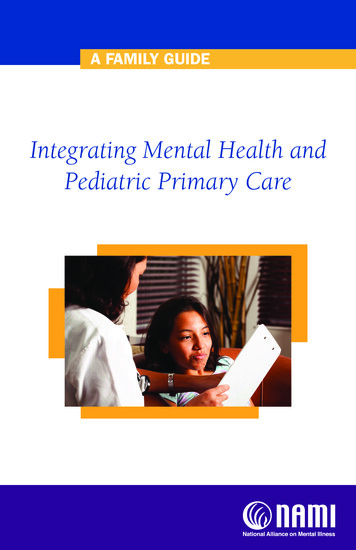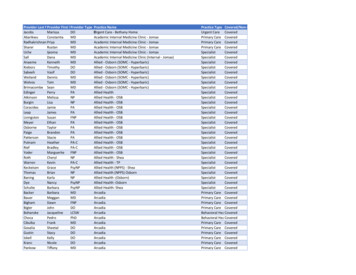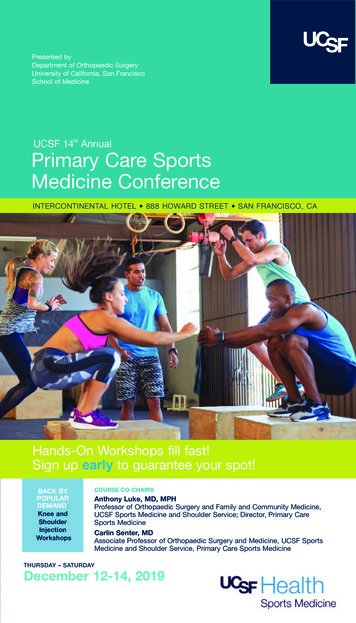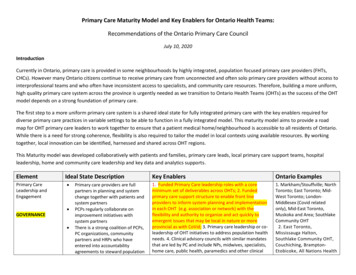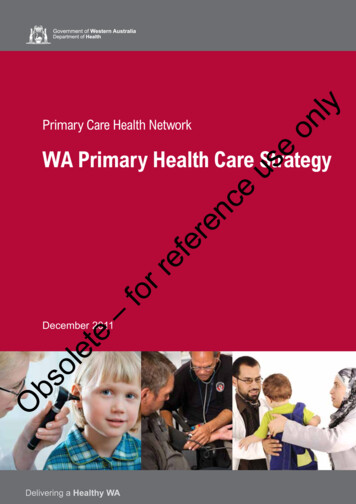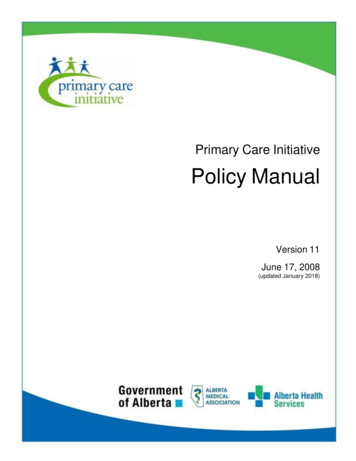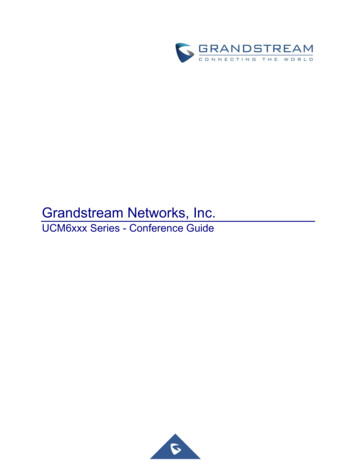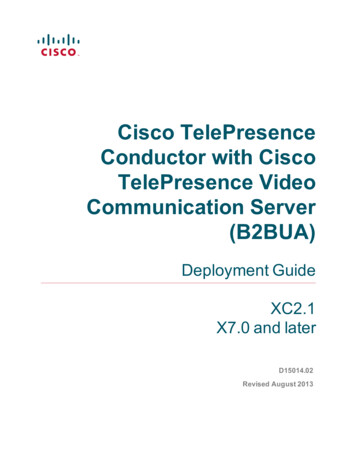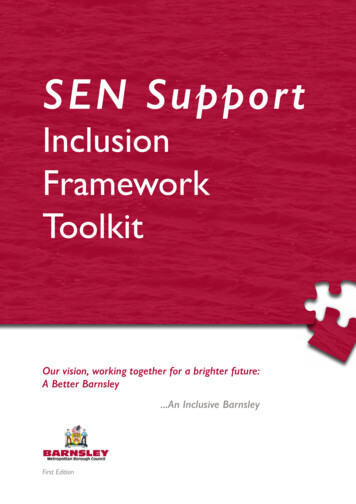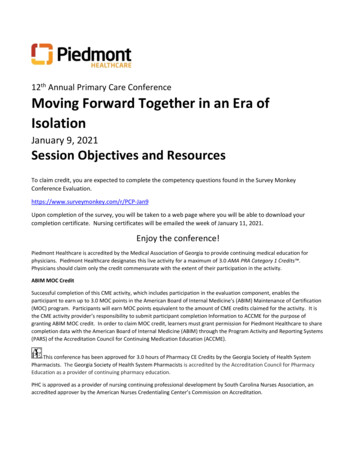
Transcription
12th Annual Primary Care ConferenceMoving Forward Together in an Era ofIsolationJanuary 9, 2021Session Objectives and ResourcesTo claim credit, you are expected to complete the competency questions found in the Survey MonkeyConference Upon completion of the survey, you will be taken to a web page where you will be able to download yourcompletion certificate. Nursing certificates will be emailed the week of January 11, 2021.Enjoy the conference!Piedmont Healthcare is accredited by the Medical Association of Georgia to provide continuing medical education forphysicians. Piedmont Healthcare designates this live activity for a maximum of 3.0 AMA PRA Category 1 Credits .Physicians should claim only the credit commensurate with the extent of their participation in the activity.ABIM MOC CreditSuccessful completion of this CME activity, which includes participation in the evaluation component, enables theparticipant to earn up to 3.0 MOC points in the American Board of Internal Medicine’s (ABIM) Maintenance of Certification(MOC) program. Participants will earn MOC points equivalent to the amount of CME credits claimed for the activity. It isthe CME activity provider’s responsibility to submit participant completion Information to ACCME for the purpose ofgranting ABIM MOC credit. In order to claim MOC credit, learners must grant permission for Piedmont Healthcare to sharecompletion data with the American Board of Internal Medicine (ABIM) through the Program Activity and Reporting Systems(PARS) of the Accreditation Council for Continuing Medication Education (ACCME).This conference has been approved for 3.0 hours of Pharmacy CE Credits by the Georgia Society of Health SystemPharmacists. The Georgia Society of Health System Pharmacists is accredited by the Accreditation Council for PharmacyEducation as a provider of continuing pharmacy education.PHC is approved as a provider of nursing continuing professional development by South Carolina Nurses Association, anaccredited approver by the American Nurses Credentialing Center’s Commission on Accreditation.
2021 Primary Care Conference Resource Booklet – Jan. 9, 2021Practical Aspects of Assessment and Management of Depression in the Primary CareSetting Rohini Mehta, MDRohini Mehta, MD is an assistant professor in the Department of Psychiatry and Health Behavior and a boardcertified Psychiatrist. She earned a Bachelor's of Science degree from McGill University in Montreal, Q.C., andher medical degree from the Virginia Tech Carilion School of Medicine in Roanoke, VA. After completing herresidency in psychiatry from MedStar Georgetown University Hospital in Washington, D.C., where she servedas Chief Resident, Dr. Mehta held a clinical position at the Charlie Norwood Veterans Affairs Medical Center inAugusta, GA before joining the faculty at the Medical College of Georgia to serve as a Clinician Educator. Dr.Mehta has received numerous accolades, including induction into the Gold Humanism Honor Society, theLeonard M. Tow Humanism in Medicine award, the American Psychiatric Association ResidentRecognition Award, and a teaching award. Her clinical interests include mood and anxiety disorders, and sheis passionate about medical education.Learning Objectives:At the conclusion of this session, the learner will be able to:1. Recognize symptoms consistent with a depressive disorder2. Understand the role and utility of rating scales in the assessment of depression3. Understand the initial treatment rationale when depression is identifiedCompetency Questions:Question 1: Which of the following factors, if present, would be inconsistent with a diagnosis of majordepressive disorder?A)B)C)D)E)History of hypomaniaNo prior suicide attemptLack of response to a 12 week SSRI trialAbnormal findings on a CBC, especially low H/HAny lifetime history of recreational drug useQuestion 2: A 37y.o. female come in 4 weeks after her initial appointment, where she was diagnosed with adepressive disorder and started on sertraline 25mg x 1 week, which was then increased to 50mg daily. Shereports a partial response to the medication as evidenced by her PHQ-9 score decreasing from a 17 to 13. Shedenies suicidality or medication related side effects. What is the next best step in management?A)B)C)D)E)Continue current dose of sertralineRecommend an internet-based psychotherapy programIncrease sertraline to 100mg daily (max recommended dose is 200mg daily)Start bupropion for augmentation of anti-depressantSwitch sertraline to fluoxetine for management of depressionResources for further study:1)Park LT, Zarate CA Jr. Depression in the Primary Care Setting. N Engl J Med. 2019 Feb 7;380(6):559-568.doi: 10.1056/NEJMcp1712493. PMID: 30726688; PMCID: PMC6727965.2 Page
2021 Primary Care Conference Resource Booklet – Jan. 9, 20212)American Psychiatric Association Practice Guideline for the Treatment of Patients With MajorDepressive w/sitewide/practice guidelines/guidelines/mdd.pdfSubstance Use Disorder Screening Richard Amar, MDDr. Richard Amar is a board-certified General and Addiction psychiatrist. He obtained his medical degree fromMCP-Hahnemann University School of Medicine in Philadelphia, Pennsylvania, and completed his GeneralPsychiatry Residency and Addiction Psychiatry Fellowship at Emory University School of Medicine in Atlanta,Georgia. Prior to joining the Talbott medical staff in 2011, Dr. Amar worked with veterans for eight years at theAtlanta Veterans Affairs Medical Center, where he was the Medical Director of the Evening Intensive Outpatient(IOP) and the STaR (Substance Abuse, Trauma, and Recovery) Programs. Dr. Amar has a specific interest indevelopmental and psychological trauma, and is trained in Eye Movement Desensitization and Reprocessing(EMDR). He is a coauthor of several peer-reviewed addiction journal articles. Dr. Amar’s approach to patientcare is holistic, combining his expertise in pharmacology and psychotherapy with other modalities includingnutrition, exercise, mindfulness and yoga.Learning Objectives:At the conclusion of this session, the learner will be able to:1. Determine when substance use disorder (SUD) screening is indicated.2. Utilize evidence-based screening tools with patients in the primary care or other settings.3. Determine next best steps based on screening results.Competency Questions:Question 1: Which of the following is TRUE of screening for SUDs in the primary care setting?A) Primary care providers should expect to see less SUDs, and possibly no SUDs, over the comingmonths.B) SUDs are uncommon in the primary care setting.C) Primary care providers play an important role in the evaluation and treatment of SUDs.D) We are seeing increased SUDs due to increased hand- washing.Question 2: Which of the following is NOT an evidenced-based screen for SUDs?A) CAGE-AIDB) AUDITC) TWEAKD) SOUS-VIDEE) CRAFFTQuestion 3: True or False: There are no evidence-based guidelines or standards for treating SUDs in the primarycare setting.Resources for Further Study https://crafft.org/about-the-crafft http://msc.sagepub.com/content/15/1/50.full https://www.asam.org/asam-criteria/about3 Page
2021 Primary Care Conference Resource Booklet – Jan. 9, 2021 ations/assessingalcohol/instrumentpdfs/74 tweak.pdfReferences and Acknowledgements https://www.samhsa.gov https://www.drugabuse.gov https://www.asam.org https://www.niaaa.nih.gov CDCHAN-00438; CDC Health Alert Network, December 17, 2020 The Nielsen Company. Rebalancing the COVID-19 Effect on Alcohol Sales. May 7, 2020 Pollard MS, Tucker JS, Green HD. Changes in Adult Alcohol Use and Consequences During the COVID-19Pandemic in the US. JAMA Network Open 2020 3(9):e2022942 Aldridge A, Linford R, Bray J. Substance use outcomes of patients served by a large US implementationor Screening, Brief Intervention and Referral to Treatment (SBIRT). Addiction. 2017 Feb 112 Suppl 2:4353. Galanter M, Kleber H. Textbook of Substance Abuse Treatment, 4th ed. APPI, Washington 2008. Parran T (2006). Substance Abuse Screening, Assessment and Brief Intervention. Chicago, IL. ASAMReview Course in Addiction Medicine. Russell M. New Assessment Tools for Risk Drinking During Pregnancy: T-ACE, TWEAK and others. 1994Alcohol Health and Research World. Sokol RJ. Delaney-Black V. Nordstrom B. Fetal alcohol spectrum disorder. JAMA. 2003;22:2296–2999. US Preventative Services Task Force. Screening and Behavioral Counseling Interventions to ReduceUnhealthy Alcohol Use in Adolescents and Adults. JAMA. 2018;320 (18) 1899-1909. Watrous R (2015). Screening, Assessment, and Brief Intervention. Paradise, lications/assessingalcohol/instrumentpdfs/74 tweak.pdfViolence Prevention in Healthcare Mike Hodges, MDMike has been a pioneer in proactive security solutions including leading the development of a collaborativeworkplace violence prevention program that has reduced incidents of workplace violence by over 50% at hisfacility. Prior to healthcare, Mike was a member of the U.S. Army where his service included response toHurricane Katrina, and combat tours in both Iraq and Afghanistan. He is a recipient of the Vizient BrillianceAward for Innovation, the 2018 Montague Boyd Excellence in Publishing Award, the Bronze Star Medal, and theHumanitarian Service Medal among other awards. Mike has published articles in international journals andpresented nationally related to healthcare violence prevention and healthcare security officer training. Mikecurrently edits and distributes the Proactive Security blog, and is a co-host of the Proactive Security Podcast.Learning Objectives:At the conclusion of this session, the learner will be able to:1. Understand the scope of workplace violence within a healthcare environment.2. Know the common pattern of escalating behavior.3. Have an understanding of practical de-escalation responses and personal safety techniques.4 Page
2021 Primary Care Conference Resource Booklet – Jan. 9, 2021Competency Questions:Question 1: Which industry is the most violent industry in the United States according to Bureau of LaborStatistics data?A) Healthcare and social assistanceB) Retail tradeC) ManufacturingD) ConstructionQuestion 2: True or False – When a person is becoming defiant and verbally aggressive it is important to utilize ateam approach to help set limits and mitigate potential violence.Question 3: True or False – Often your instincts can help you mitigate victimization, it is important to listen toyour gut feelings about danger.Resources for further iskAssessment/dp/1606239848/ref sr 1 1?dchild 1&keywords clinicians guide to violence risk&qid 1610047152&s audible&sr llection/48907176-3B11-4B24-A7C0FF756143C7DE/IAHSS Foundation - De-Escalation 7DE/IAHSS Foundation - Threat Assessment Strategies to Mitigate Violence in Healthcare.pdfThe Orthopedic Physical Exam Tracy Ray, MDDr Tracy Ray is a native of Marietta and a graduate of Berry College who then went on to complete his medicalschool training at MCG in Augusta. After completion of his FM residency in Tuscaloosa, AL, he trained in SportsMedicine at the Cleveland Clinic in Cleveland, OH. He is happy to now have returned to his home state afterworking with Dr James Andrews in Birmingham and most recently, with the Duke University Blue Devils inDurham, NC. He is the current President of the largest, physician-member, sports society in the world- theAmerican Medical Society for Sports Medicine.Learning Objectives:At the conclusion of this session, the learner will be able to:1) Describe components of a thorough MSK exam of the shoulder.2) Describe the components of a thorough MSK exam of the knee.3) Use pertinent negatives and positives of the exam to create a differential diagnosis.5 Page
2021 Primary Care Conference Resource Booklet – Jan. 9, 2021Competency questions:Question 1: Common ligamentous tests for the knee include A)B)C)D)E)Lachman testMcMurray maneuverPosterior drawer testA and CAll of the aboveQuestion 2: 28 yo male with no previous or acute history of trauma to his right shoulder presents with 2 weekhistory of insidious onset of right shoulder pain. On exam he has full ROM with a painful arc, positive Hawkin’sand Neer tests but a positive drop-arm sign. What is the most likely diagnosis?A)B)C)D)Shoulder dislocationAdhesive capsulitisRotator cuff tendonitis/subacromial bursitisAC separationResources for Further Study1.2.3.4.Macleod's Physical Examination Of The Musculoskeletal System OSCE Guide 2016https://www.youtube.com/watch?v 8RzL0YhjfXcStanford video: lder.htmlKnee Pain in Adults and Adolescents: The Initial Evaluation in American Family tmlEverything You Need to Know About Knee Pain Kelly Ward, PA-CKelly Ward received his Physician Assistant degree from Emory University in Atlanta, Georgia. He has worked inthe Athens area for over 20 years. Prior to attending Physician Assistant school, Kelly worked as an athletictrainer with the University of Georgia. He currently serves as a Team Clinician with the University of Georgia andassists Dr. Robert Hancock in all aspects of orthopedic sports medicine care. Kelly treats all sports relatedorthopedic conditions. He has a special interest in non-operative treatment and prevention of athletic injuries.He is proficient in the utilization of musculoskeletal ultrasound as a means of both diagnostic and treatment ofathletic injuries. In his spare time, Kelly enjoys spending time with his family and friends. He is a sportsenthusiast and enjoys the outdoors.Learning Objectives:At the conclusion of this session, the learner will be able to:1. Discuss common causes of knee pain seen in the primary care setting2. Review common clinical presentations, diagnostic tools, and treatment options3. Discuss referral for orthopedic surgical management6 Page
2021 Primary Care Conference Resource Booklet – Jan. 9, 2021Competency QuestionsQuestion 1: All of the following recommendations listed in the clinical practice guideline for the treatment ofosteoarthritis demonstrate Level I evidence except?A) Patients with symptomatic OA of the knee who are overweight (BMI 25) should be encouraged to loseweight and maintain their weight at a lower level with an appropriate program of dietary modificationand exerciseB) Patients with symptomatic OA of the knee be encouraged to participate in low-impact aerobic exerciseC) Patients should not receive a prescription for glucosamine and/or chondroitin sulfate or hydrochloridewhen presenting with symptomatic OA of kneeD) Patients with symptomatic OA of the knee should perform range of motion/flexibility exercises on adaily basisQuestion 2: Which of the following intra-articular injection treatment option has demonstrated Level I evidenceof decreasing pain in a symptomatic OA knee with a Kellgren-Lawrence Grade I-II weight bearing radiograph forup to one yearA)B)C)D)Hyaluronic AcidKetorolacLeukocyte poor PRPCorticosteroidExercise is Medicine for Back Pain Joel Hardwick, ACSMJoel Hardwick received his undergraduate degree in Exercise Science from Georgia State University in Atlanta,Georgia. He has worked as a Clinical Exercise Physiologist and Cancer Exercise Trainer for Piedmont AtlantaHospital for more than 4 years. Joel has experience translating exercise as medicine for a wide range of patientspresenting with cardiovascular, pulmonary, or metabolic diseases. He has a unique interest in exercise oncologyand actively supports and manages pre-habilitation/rehabilitation efforts in the clinical practice, particularly withbreast and pancreatic cancers. Joel is proficient in applying physiological concepts and their responses toexercise as a means for managing and treating chronic diseases over all age ranges. Joel stays active by playingpickleball and cycling on the Atlanta beltline.Learning Objectives:At the conclusion of this session, the learner will be able to:1. Understand clinical exercise physiology and its role in Exercise as Medicine2. Identify the utility of exercise as a tool to prevent and manage low back pain3. Explore common myths associated with exercise and low back pain and develop safe and effectivestrategies to integrate into practice.Competency QuestionsQuestion 1: Patient A is a 45-year-old male with no known history of cardiac, pulmonary, or metabolic diseasepresents to clinic today for annual check up. He is sedentary and mentions he has a high-pressure desk job andhas felt slight low back tightness but no pain. What recommendations would you give for this patient?7 Page
2021 Primary Care Conference Resource Booklet – Jan. 9, 2021A)B)C)D)Stretch the hamstrings and low back.Strengthen core.Recommend a yoga or Pilates class.Encourage proper sitting form, walking program, and core stability exercise.Question 2: Patient X is a 57-year-old female with a history of hypertension, type II diabetes, obesity, and issedentary. She presents in clinic today for a routine check up but mentions she has had low back pain on and offfor 6-months. What recommendations would you give her?A)B)C)D)Walk it off, you will be okay.Refer to a specialist.Tell her to lose weight to reduce back pain.Give her an injection.Resources:1. Kim LH, Vail D, Azad TD, et al. Expenditures and Health Care Utilization Among Adults With NewlyDiagnosed Low Back and Lower Extremity Pain. JAMA Netw Open. 2019;2(5):e193676.2. Shiri R, Coggon D, Falah-Hassani K. Exercise for the Prevention of Low Back Pain: Systematic Review andMeta-Analysis of Controlled Trials. Am J Epidemiol. 2018;187(5):1093-1101.3. de Campos TF, Maher CG, Fuller JT, Steffens D, Attwell S, Hancock MJ. Prevention strategies to reducefuture impact of low back pain: a systematic review and meta-analysis. Br J Sports Med. 2020.4. Hoy D, Brooks P, Blyth F, Buchbinder R. The Epidemiology of low back pain. Best Pract Res ClinRheumatol. 2010;24(6):769-781.5. Vanti C, Andreatta S, Borghi S, Guccione AA, Pillastrini P, Bertozzi L. The effectiveness of walking versusexercise on pain and function in chronic low back pain: a systematic review and meta-analysis ofrandomized trials. Disabil Rehabil. 2019;41(6):622-632.6. Ronai P. Exercise Recommendations for Cardiac Patients with Chronic Nonspecific Low Back Pain.Journal of Clinical Exercise Physiology. 2019;8(4):144-156.8 Page
Georgia. Prior to joining the Talbott medical staff in 2011, Dr. Amar worked with veterans for eight years at the Atlanta Veterans Affairs Medical Center, where he was the Medical Director of the Evening Intensive Outpatient (IOP) and the STaR (Substance Abuse, Trauma, and Recovery) Programs. Dr. Amar has a specific interest in
